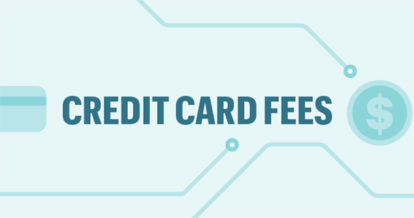By now, most restaurateurs have discovered that merchant credit card fees are a necessary evil.
In an increasingly cashless society, people want the choice to swipe, tap, dip, enter their PIN, or use their phones to authorize mobile payments. And as an accommodating merchant, you want to give your customers what they want – even if that means credit card fees become one of your biggest business expenses.
That’s why it pays to be prepared when entering into an agreement with a restaurant merchant services provider, the company that provides you with payment terminals, and the service that clears and routes credit card transactions.
There’s only one problem.
The fee structures associated with accepting credit cards are head-swimmingly complex.
There are processing fees, flat fees, and situational fees. Some are negotiable; some aren’t. Entering into an agreement with a payment processor is a lot like hiring a contractor to remodel your restaurant: it’s important to get a few quotes and negotiate the fine points.
To help you sort it all out, this article will cover everything you need to know about merchant credit card fees, including:
- What are credit card fees?
- How much merchants pay for credit card fees on average
- 5 steps to reduce your merchant credit card fees
Remember, you don’t have to take a master class in economics to secure a reasonable rate from a reputable payment processor. All it takes is preparation, an understanding of what’s negotiable, and a keen eye to determine the best provider for your business.
Here are 5 steps that’ll help you get the best payment processing rate for your restaurant.

Find out which fees are negotiable and how to get the best price.
What Are Credit Card Fees for Merchants?
Before you can probably negotiate your fees, let’s address the question of what are credit card fees for merchants.
In the world of payment processing, the businesses that accept credit cards (like restaurants) are known as merchants. And if you accept credit card payments in your restaurant, you’ll be subject to what’s known as credit card merchant fees.
Merchant credit card fees are made up of several different types of fees. Each credit card company (i.e. Mastercard, Visa, etc.) sets a standard fee that the issuing bank or financial institution charges whenever a card is used. These fees are typically a percentage of the transaction plus a flat fee.
In addition to the fees charged by credit card companies, the restaurant merchant services provider that processes your credit card payments also charges a small fee – typically a percentage of the transaction amount plus a flat fee for each credit card purchase.
Together, all these fees make up the credit card merchant fees you pay when you accept credit card payments.
How Much Are Merchant Credit Card Fees?
When budgeting for credit card processing fees, it can be helpful to have a number in mind. Unfortunately, these numbers can vary quite a bit between the four major credit card networks and the merchant services provider.
Based on an estimate by Payment Depot, the average costs for merchant credit card fees are:
- 1.5% to 2.9% for swiped/dipped cards
- 3.5% for keyed-in transactions (also known as a card-not-present transaction)
Keep in mind that these averages are only rough estimates because there are many different factors that can impact your rates. For instance, the more secure the form of payment, the less expensive it usually is (e.g. swiping a card through a credit card reader costs more per transaction than a restaurant mobile payment because the former is more open to fraud).
How to Reduce Credit Card Fees for Your Business
No restaurateur wants to pay hefty credit card fees each month or add a surcharge to recoup some of the money paid out to their merchant services provider. So what can you do to lower this expense?
Below, we cover five steps you can take to reduce credit card fees for your business and keep more money in your pocket.
Step 1: Understand Your Business
Before you even approach a merchant services provider, it’s important to anticipate the information they’ll need from you to prepare a customized rate.
If you have accurate, concise answers, the process will run smoothly and you’ll be in a better position to negotiate applicable credit card fees.
Here are some of the questions a provider will ask:
- What are your monthly sales?
- What is your average ticket size?
- What is your monthly or annual credit card processing volume?
- What type of payment terminal do you want? (i.e. fixed terminals or wireless ones that let you process mobile payments)
- Do you want to rent or purchase your payment terminal?
- Do you want an integrated payments solution that talks to your POS – or one that operates independently?
If you’re setting up a payment processing agreement before you’ve opened your restaurant, you’ll need to provide projections.
As mentioned above, rates vary among merchant services providers, but are usually calculated per transaction and range between 1% and 4%. Some providers also add a fixed dollar amount per transaction, typically from $0.10 to $0.30.
Merchant services providers typically offer better rates for higher-volume businesses in lower-risk industries, such as large grocery stores, retail chains, and restaurants that do real-time transactions (i.e. nothing with recurring charges or future delivery).
However, it’s important to provide these companies with realistic, achievable numbers (your answers to the questions above), to make sure you get the most accurate rate quotes possible.
Step 2: Get Quotes from Multiple Processors
Now that you’ve put together a package of your numbers or projections and have considered your payment terminal needs, it’s time to shop around for a merchant services provider.
Merchant services providers (also known as merchant account providers) supply merchants (like restaurants) with every payment component needed to accept non-cash modes of payment, both online and offline. TouchBistro Payments is an example of a merchant services provider.
While cost is a big factor when selecting a provider, it shouldn’t be the only criteria. It’s important to align with a trusted company that has a good reputation.
There are plenty of providers who charge bargain-basement rates but may not provide dependable customer service. You’ll want to strike a good balance between a reasonable rate and a stable, trustworthy company – ideally one that’s affiliated with a major financial institution.
Keep in mind that your payment processor – the company working behind the scenes to maintain the technical communication between merchant services providers and the banks – is chosen by the bank associated with your merchant services provider. For example, First Data and Vantiv are two well-known payment processors.
And while payment processing partners have no direct relationship with your business, they play an important role and should factor into your decision as to which merchant services provider you go with.

Find out which fees are negotiable and how to get the best price.
Tips on Finding Payment Processing Companies:
- Reach out to other, comparable restaurants and ask what companies they use. Ask them what they like or don’t like about their current provider, including services and fees.
- Look for big names in the industry. If they’ve been around for a while, chances are they’re a legitimate, dependable business.
- Research multiple third-party reviews before reaching out to a merchant services provider. If the same feedback – including features, benefits and disadvantages – keep coming up you’re probably getting a good picture of what they offer.
- Look for unique differentiators. Many providers offer services that set them apart, like the security of being backed by a reputable financial institution, accurate billing, or excelling in areas like mobile credit card processing.
Step 3: Understand Credit Card Fees
While individual fees may vary, all merchant services providers have the same basic fee structure. On every statement, you’ll find three types of fees: processing, flat, and situational.
When you’re comparing providers, take a look at the prices associated with each type of fee. It’s important to understand which are negotiable and which are not.
Processing Fees
Providers are responsible for capturing fees from credit card brands and issuing banks and providing a routing service. They charge a number of credit card processing fees to recoup the charges and to be compensated for their services.
| Type of fee | What is it? | Negotiable? |
|---|---|---|
| Discount rate (aka qualified rate, merchant rate, discount rate, or MDR) | The fees for processing a payment made with a basic credit card (i.e. a card with no perks/rewards). It’s charged as a percentage of the total transaction (e.g. 1.5%). Payment processors may make this “floor” price intentionally low to appear attractive to merchants. Beware: If it’s too low for them to make any profit, they’re probably jacking up fees elsewhere. | Yes |
| Interchange Fee | Each credit card brand (e.g. Visa, Mastercard, American Express, etc.) has a published, percentage-based fee that they charge every time one of their cardholders uses their credit card. It’s the cost of authorizing the charge. The interchange fee is higher for cards with perks or rewards than it is for basic cards. The payment processor is responsible for paying this fee – and passes the cost on to the merchant. | No |
| Non-qualified rate | This is a fee added to the discount rate (above) when non-basic credit cards (rewards, corporate, business) are used – and on transactions completed over the phone when the card is not present. These cards (and card-not-present transactions) carry higher risks, so they’re processed at a higher rate. | Yes |
| Card brand (assessment) fee | This is a fee paid to the card brand (e.g. Visa, Mastercard) on every transaction. The card brand sets the fee, and it applies to all types of cards (basic to premium). Payment processors may or may not mark this up. | No |
| Transaction Fee | A dollar amount fee on every transaction. | Yes |

Find out which fees are negotiable and how to get the best price.
Flat Fees
Flat fees will vary by provider. Here are some of the most common types of flat fees.
| Type of fee | What is it? | Negotiable? |
|---|---|---|
| Annual fee | Charged once a year for the payment processor’s services. | Yes |
| Monthly fee | Charged every month for the payment processor’s services. | Yes |
| Batch fee | The cost of sending each “batch” of completed transactions for the day to the bank for payment. | Yes |
| Network access fee | A fee charged by the credit card brand for accessing their network. | Yes |
| Online reporting fee | The fee for the ability to view your statement online. | Yes |
| PCI fee | Meeting the Payment Card Industry (PCI) Data Security Standard is mandatory. All payment processors must ensure their merchants are following the rules. Some payment processors charge an additional fee to ensure compliance. | Yes |
| Statement fee | The cost of preparing and providing your billing statement. You may try to bypass this fee by asking for online-only access. | Yes |
| Terminal fee | The cost of renting, leasing, or buying a terminal. | Yes |
Situational Fees
As their name suggests, situational fees are charged when specific situations arise. They aren’t necessarily regular or predictable, so it’s important to understand the types of fees that could be incurred.
Here are some of the ones to watch for.
| Type of fee | What is it? | Negotiable? |
|---|---|---|
| Chargeback fee | This is levied when a customer claims fraud or wants a refund. The payment processor will charge this fee for processing the chargeback. | No |
| Retrieval request fee | This is a fee for retrieving information when a customer requests a chargeback (refund). | No |
| International fee | Applied when a customer uses an international credit card. | No |
| Liquidated damages fee | If you choose to terminate your contract with the payment processor before the agreed-upon date, they may charge a fee associated with the monthly profit value of your account. | Yes |
| Monthly minimum fee | Merchants who fail to reach their transaction total for the month or year may be charged this fee. The payment processor may choose to charge you the difference between the agreed-upon monthly minimum and the actual transactions. | Yes |
| Non-sufficient funds (NSF) fee | If you don’t have enough funds in your account to pay the payment processor fees, you will be charged a fee. | No |
| Set-up fee | The cost of setting up or creating an account with a payment processor. | Yes |
Step 4: Compare, Compare, Compare
For the restaurant industry, merchant service providers typically provide two types of pricing models:
- Cost Plus
- Flat Fee
Cost Plus Pricing
Cost plus pricing is one of the most popular pricing models and is what you can expect with TouchBistro Payments.
Most restaurants today use the cost plus model because of its transparency and easy-to-understand terms and fees. Cost plus pricing also tends to offer the most equitable rate for restaurants.
Under this model, you’re responsible for the non-negotiable interchange fee (for the type of credit card) plus the payment processor markup. The markup is a fixed percentage of the total check, the card brand fee, and a per-transaction flat fee.
The cost plus pricing model has a straightforward formula like this:
1.54% (interchange fee) + 0.10% (payments processor markup) + 0.10% (card brand fee) + $0.25 (processor markup fee) = 1.74% + $0.25 total processing fees
This type of simple formula makes it easy to compare processing fees from company to company.
Fixed Rate Pricing
Another common pricing model is fixed rate (also known as flat fee) pricing.
With this pricing model, the payment processor charges a percentage-based fee plus a fee per transaction. In this case, it doesn’t matter what type of card is used (e.g. a student card vs. a platinum card) or the method of payment (e.g. magstripe vs. digital payment). Here’s an example:
2.75% + $0.25 = 2.75% + $0.25 total processing fees
Some restaurateurs like the fixed rate pricing model because it’s simple and predictable, meaning they know what they can expect to pay in merchant credit card fees.
However, there are some major downsides to fixed rate pricing:
- The rates tend to be higher because providers are trying to cover the cost of all card types.
- Your rates can be raised at any time (the right to raise the rate without warning or negotiation is built into most contracts).
- You aren’t able to take advantage of the discounts associated with basic cards like no-fee credit cards and debit cards.
While there are pros and cons to each pricing mode, keep in mind that it’s not always possible to compare apples to apples when reviewing quotes from merchant services providers. Some providers may charge low fees in one place but higher somewhere else. Some may include hardware such as electronic credit card readers (or terminals) in the agreement.
Take a look at the flat and situational fees as well. Using our negotiating cheat sheet, focus on the ones that are negotiable and consider asking for a better rate on some or all of them.
You’ll also want to look at contract termination terms. You may decide the flexibility of a shorter-term contract outweighs the benefits of a lower cost elsewhere.
Step 5: Negotiate
Once you’ve narrowed it down to one or two providers, it’s time to make sure you’re getting the best deal possible. Here are some tips on negotiating:
Be Prepared
Don’t just take a cursory glance at the quotes you’ve gathered from each provider. Pore over them so you understand exactly where and how they’re making money. A low rate on one credit card fee may be neutralized with an excessive fee elsewhere. You should be able to list the pros and cons of each quote before you head to the negotiating table. Use our cheat sheet to help you keep track of what each of the credit card fees are for and which ones are negotiable.
Ask Questions
After you’ve gone over the quote with a fine-toothed comb, book a call or in-person meeting and ask the sales rep to go over it with you, line by line. Ask them to explain each feature and fee. It wouldn’t hurt to gasp or wince from time to time. Seriously. They may react to your body language or verbal cues with a better price. If not, when you arrive at each negotiable fee, ask for the best price they have. Point out what their competitors are charging for merchant credit card fees.
Demand Price Matching
If you’ve uncovered a better price elsewhere, share it with the merchant services provider you want to work with to see if they can price-match. Even if they can’t meet the exact price, they may be able to offer perks like free EMV-compliant payment terminals or a shorter contract. This may be worth more than a lower fee.
Get Advice from Other Professionals
Take your time when reviewing quotes from providers. Don’t let them rush you into making a decision. Consider sharing them with an accountant or lawyer to help you find the right overall fit.
“Is That the Best You Can Do?”
When you think you’ve negotiated your contract to the lowest possible price and the best possible features, take one further step before you close the deal. Be absolutely sure that they are giving you the most optimal pricing. It’s surprising how much you can reduce credit card fees for your business just by asking “is that the best you can do?”.
When you consider the number of credit card transactions your restaurant will ultimately process every day, it’s well worth the time it takes to understand credit card fees and negotiate them to within an inch of their life.
The best payment processing rate for your restaurant is out there. It’s up to you to find it.
Ready for a complete payment processing solution for U.S. restaurants?
Outside of the U.S.?
Learn how to save money on payment processing fees
Sign up for our free weekly TouchBistro Newsletter







